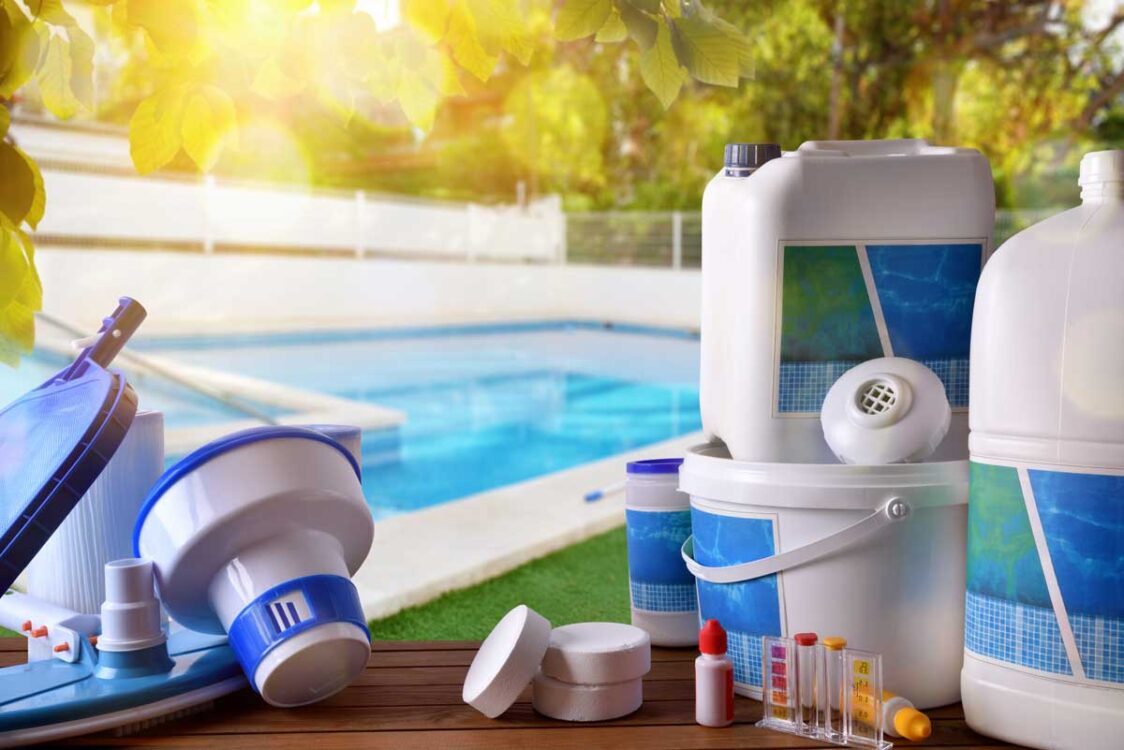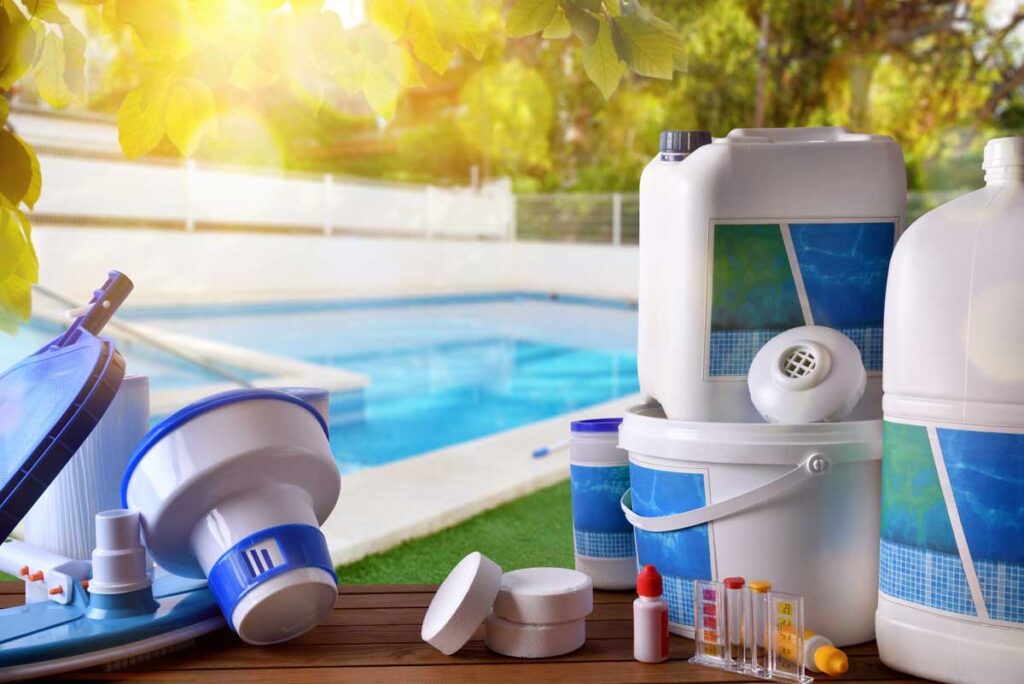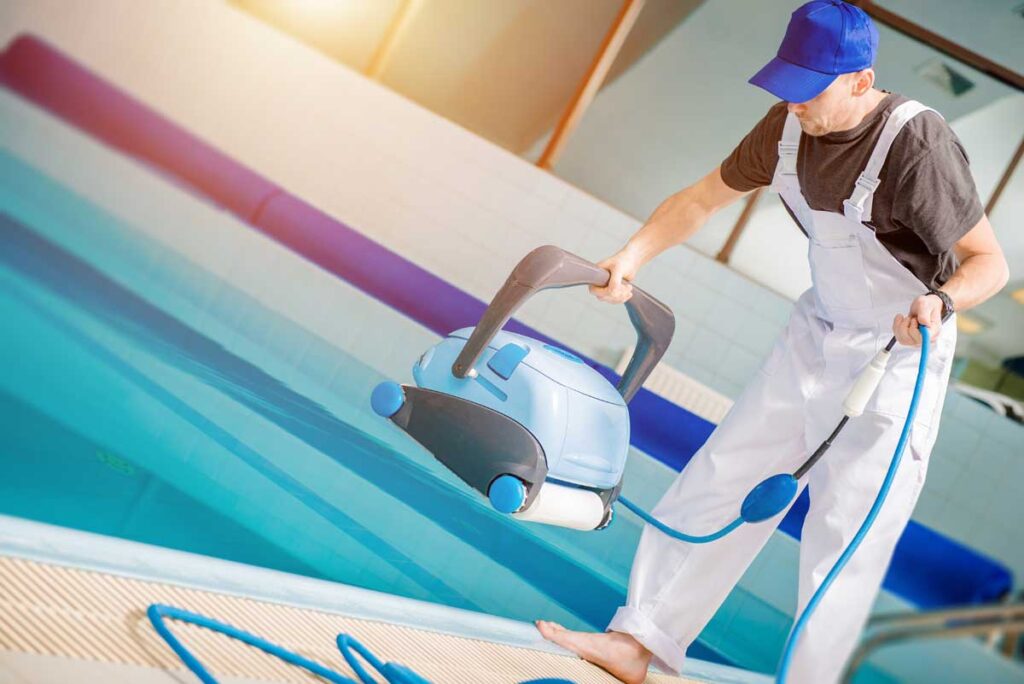
It is crucial to practice good pool chemistry, which is simple to do. We’ll provide you all the information you need to keep your pool clear and clean in this tutorial.
Basic Swimming Pool Chemistry for Beginners
Would it not be fantastic if you could simply fill your pool with water and then never have to think about algae developing, germs building up, or the water simply becoming a horrible breeding ground for all kinds of nasty toxins and organisms? Yes, routinely checking the water and adding chemicals to the pool may be time-consuming and boring, but it is extremely required.
When your pool becomes so unbalanced or infected with algae that the only option is to drain it and start over, a little forward work means a lot less treatment later. While maintaining your pool’s cleanliness and sanitization may not be the most enjoyable activities, they are also not very challenging. All you need to keep your pool clean and swimmable is a little basic knowledge of pool chemistry, the appropriate tools and materials, and a desire to do so.

In Maryland, Washington, DC, and Virginia, Nachman Pools is pleased to provide maintenance plans and services to contractors and homeowners.
You will be assisted by our knowledgeable staff as they walk you through the specifics of maintaining your swimming pool. They will be there whenever you need them for more advice.
What should the chemistry of my pool be?
- pH: 7.4 to 7.6
- 100 to 150 ppm of alkalinity
- Calcium Hardness: For plaster pools, 175 to 225 ppm, and 225 to 275 ppm
- 1 to 3 ppm for salt or chlorine pools (It is recommended to keep it at 3 ppm)
- 3–5 ppm for bromine pools
- 30–50 ppm for biguanide pools
- 0.5 ppm of chlorine for mineral system pools
Water Balance of the Swimming Pool
Your pool’s water is sensitive, so it needs to be balanced in order to achieve ideal pool harmony. It must be the perfect amount of soft and firm together in harmony—just ideal!
Maintaining the pH of your pool’s water between 7.4 and 7.6, which is slightly above neutral on the pH scale, is an essential step for balancing your swimming pool at your sanctuary.
To keep this in balance, you will need three main elements:
- pH values
- levels of alkalinity
- degrees of calcium hardness
pH Values
The range of the ideal pH level is 7.4 to 7.6.
pH is unstable on its own. The pH level can be impacted by swimmers, rainwater, and just about everything else that enters the water. If your water’s pH is low, it implies it’s acidic; if it’s high, it means it’s basic.
Our tears are pH neutral, just to give you an idea of how pH functions. When we sobbed, it would burn if they had a low pH. Furthermore, a high pH would dry out our eyes.
Due to the frequent changes in pH levels, always maintain an adequate supply of pH Increaser on hand. If you’re having trouble maintaining a pH balance in your pool, it is usually recommended to monitor your alkalinity levels as well. Adding alkinity increasers raises the pH level in your pool, so it’s like killing two birds with one stone!

Defining Alkalinity Levels
Between 100 and 150 ppm is the ideal alkalinity level.
By absorbing significant changes to the water before they have an impact on the pH, alkalinity functions as a pH buffer, preventing the pH from moving dramatically up and down the pH scale.
Alkaline levels can fluctuate quite a bit, so it’s a good idea to keep plenty of alkalinity increaser on hand.
Strength of Calcium
Between 175 ppm and 300 ppm is the ideal calcium hardness level.
Without calcium, your water will get ravenous and look for other sources of the mineral by chowing down on the plaster of your pool, among other things. This is the general definition of calcification on your pool’s walls and floor.
Your pool walls and equipment will be better protected over time if you add calcium hardness to your water. Scaling and other problems, however, might result from an excess of calcium.
How To Maintain Water Balance
Using a home test kit or test strips, it’s crucial to monitor your pH and alkalinity levels at least once a week.
You must always have these chemicals on hand in order to maintain your pool balanced:
pH-increasing agent
pH-lowering agent (hydrochloric acid)
Alkalinity Inducer
You’ll see that an agent that lowers alkalinity isn’t specified here. Here are the reasons why it is not produced by the majority of large pool chemical companies:
-Alkalinity increaser will increase both if your pH and alkalinity are low. In order to fine-tune an instrument, if the pH doesn’t reach 7.4, you might need to add a small amount of pH increaser.
-Alkalinity and pH can both be reduced by using a pH decreaser if they are both high.
-You can use a pH decreaser if your alkalinity is only high, as this will result in a high pH.
The effectiveness of your pool’s sanitizer, particularly chlorine, will increase if it is kept correctly balanced at all times.
Sanitisation
Chlorine is the most popular type of pool sanitizer, however there are others you can use, such as:
- Salt
- Stable chlorine
- Minerals
Levels of Chlorine
From 1 ppm to 3 ppm is the range for ideal chlorine levels.
Chlorine is a highly efficient and economical way to eliminate germs and algae.
You can add chlorine to the pool water in a number of ways, including:
-Chlorine tablets
-Granular chlorine or powdered chlorine
-Salt Chlorine Generator: produces chlorine from table salt.
Alternative to Chlorine: Sparkle Purifier
This is a substitute for chlorine. It works well as a pool sanitizer and even helps the water seem smoother.
These chemical packages, which come in granular/powder or tablet form, are more expensive than conventional chlorine-compatible compounds.
Nachman Pools is happy to offer maintenance plans and services for pools to contractors and homeowners throughout Maryland, Washington, DC, and Virginia.
Our staff will guide you through the technicalities of maintaining your swimming pool with their expertise. They’ll be available whenever you need them for additional guidance.
System of Minerals
When employing a mineral system, a chlorine level of 0.5 ppm is ideal.
By using a mineral system that resembles a chlorinator, silver and copper minerals are added to the water. Although considerably slower than chlorine, these minerals do function to cleanse the water.
Since chlorine is still needed, albeit in modest quantities as a backup, a mineral system is NOT a full substitute for chlorine.
Different kinds of pool chemicals
All year long, you could maintain a clean and healthy pool if you only utilized pH, alkalinity, calcium, and sanitizer solutions. However, there are a few additional products you have to be aware of in case you require or choose to employ them.
Stabilizer or cyanuric acid
The majority of chlorine products that you add to the water will be stabilized chlorine. However, if you start with fresh water, you might want to add some cyanuric acid (also known as water stabiliz
er) as a stabilizer base so that the chlorine doesn’t get burned off by the sun’s UV rays as rapidly. Your chlorine will be shielded from the sun by this chemical.
Cyanuric Acid Reducer
Your cyanuric acid levels may occasionally be higher than they should be, which can actually be problematic.
Since cyanuric acids don’t naturally dissolve, there are several ways to lower them, but if you need to solve this issue right off the bat, you may always use a Cyanuric acid reducer.
Algaecide
Algaecide is a substance that stops algae growth. The most effective algae killer is chlorine, despite the fact that there are some algaecides on the market that promise to do so.
As a backup, use algaecide. The algaecide will hold the algae at bay until you can raise the chlorine levels if your chlorine levels drop and you don’t notice it in time.
Algaecide might not be your best choice if you currently have an algae problem in your pool. Thankfully, we have a way to assist you get rid of the algae and prevent it from returning. To view our instructions on how to permanently get rid of algae, click the button below.
Floc and clarifier
A water clarifier helps by gathering all the tiny particles that are causing your water to be hazy and merging them into larger particles that your filter will have a greater chance of filtering out.
Floc, also known as a flocculant, seizes these minute particles, gathers them, and sinks them to the bottom. You will need to physically vacuum the particles out of the water using pool floc before you can use it.
Remover for stains and scale
You can use a metal remover or stain and scale remover to keep metals in solution in your water, such as copper and iron, so that your filter can filter them out.
In the event that metals are released from solution, they may stick to the pool’s walls and other surfaces and leave behind ugly stains.
In Maryland, Virginia, and Washington, DC, Nachman Pools is pleased to provide maintenance programs and services for swimming pools to builders and homeowners.
Our team will use their knowledge to help you navigate the technical aspects of maintaining your swimming pool. Any time you require extra guidance, they will be there to help.